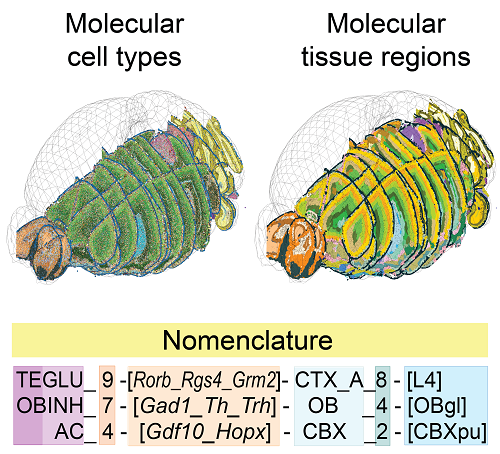By Yichun He and Hailing Shi
Navigating a complex city without a map can be baffling, much like scientists’ endeavor to decipher the brain, our most sophisticated and enigmatic organ. It’s a universe of billions of cells, each playing a distinct role in shaping our thoughts, feelings, and actions. For a long time, scientists have endeavored to identify and comprehend the varied cell types within the brain to gain insights into its intricate workings. Our recent publication in Nature marks a pivotal advancement in this quest.

Molecular cell types and tissue regions across the mouse brain
We created a detailed cell map of the mouse brain – think of it as a Google Maps for brain cells. Utilizing the cutting-edge STARmap PLUS technology, we built a spatial atlas of the mouse central nervous system with remarkable molecular detail. Our exploration delved into over one million individual cells, pinpointing approximately 230 unique molecular cell types and delineating 106 distinct molecular tissue regions.
Our map is a foundational resource that will revolutionize our understanding of the brain. It lays out a framework for how brain cells are organized and interact, providing clues to fundamental questions about brain function. This research is a steppingstone towards similar studies in other species, including humans, and offers new insights into how our brains work in health and disease.
We are thrilled to make this map publicly accessible at http://brain.spatial-atlas.net/, inviting everyone to delve into its rich details. This initiative is not confined to the scientific community; it’s a valuable resource for anyone fascinated by the workings of the brain.
This study, led by Dr. Xiao Wang, a core institute member of Broad Institute and an assistant professor at MIT Chemistry, and Dr. Jia Liu, an assistant professor of engineering at Harvard, highlights the powerful combination of technological innovation and collaborative effort in unraveling the complexities of the brain. It represents a significant leap in our ongoing journey to comprehend one of nature’s most intricate and captivating creations.
Yichun He is a PhD candidate in Jia Liu’s lab at Harvard SEAS and Xiao Wang’s lab at the Broad Institute.
Hailing Shi is a Helen Hay Whitney Foundation Postdoctoral Fellow in Xiao Wang’s lab at the Broad Institute and MIT Chemistry.
We are highlighting papers from Harvard labs published recently in Nature as part of of the NIH’s Brain Research Through Advancing Innovative Neurotechnologies initiative Cell Census Network (BICCN). Learn more about this initiative here.
Learn more in the original research article:
Spatial atlas of the mouse central nervous system at molecular resolution
Shi H, He Y, Zhou Y, Huang J, Maher K, Wang B, Tang Z, Luo S, Tan P, Wu M, Lin Z, Ren J, Thapa Y, Tang X, Chan KY, Deverman BE, Shen H, Liu A, Liu J, Wang X. Nature. 2023 Oct;622(7983):552-561. Epub 2023 Sep 27. Erratum in: Nature. 2024 Jan;625(7993):E6.
News Types: Community Stories
